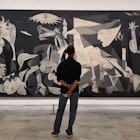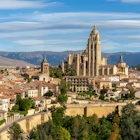
Madrid has a stellar selection of museums, but don’t stop at the big names. Hidden behind terracotta-topped walls and tucked away below the city’s streets are fascinating, lesser-known museums waiting to be discovered. From subterranean ghost stations to historical mansions with sun-soaked courtyards, here are Madrid’s best museums that you haven’t been to.

1. The Robot Museum
Tucked away in the basement of games shop Juguetrónica, this subterranean den is a treasure trove of technology. Book your slot (€5) for a tour of the uncanny machines. It’s led by two guides: one friendly human and one humanoid robot called Pepper – the world’s first robot to recognise faces and human emotions. After a short video about the history of robots, geek out on the collection which includes one of the biggest selections of robotic dogs in Europe, a 2005 Nao model and replicas of the famous Star Wars androids.
2. Museo de Anatomia
Firstly, don’t trust any opening times on the internet; this museum’s door is locked unless you confirm an appointment. Hidden in the Faculty of Medicine at Complutense University of Madrid, the Museo de Anatomia displays a vast collection of human bones, mummified body parts and intricate wax sculptures. The permanent collection features malformed baby skeletons, a 300-year-old dissection table and a wax replica of the man with two penises. It’s difficult to get in, but not impossible.

3. Museo del Romanticismo
Like a historical version of MTV Cribs, this ornate museum is a peek into the frivolous and excessive life of Madrid’s bourgeoisie during the Romantic period. Inside the 18th-century mansion find the ballroom lined with its grand piano, gilded frames and flashy antiques, or peek at more intimate belongings, like the 19th-century toiletries of Fernando VII. Finish with a coffee or a beer in the equally gorgeous cafe, with original French doors which open out onto a lush garden and water fountain.
4. Imprenta Municipal – Artes del Libro
Inside one of the last examples of 1930s functionalist architecture in Madrid, you’ll find a fascinating homage to graphic design. Standing defiant against the decline of the printed word, the collection spans machinery, typography and bookbinding, as well as changing exhibitions on the upper two floors. The permanent collection features manual printing presses from the 16th century to the 1920s, alongside a collection of lead-cast lettering that typography geeks will love. It’s free to enter and there are free guided tours available.

5. Museo Sorolla
No one captures the Spanish sunshine quite like Valencian painter Joaquín Sorolla. He moved to Madrid with his wife Clotilde and their three children in 1890, and there he created some of his best works. He sadly died following a stroke, and when Clotilde died in 1929 she bequeathed their family home and paintings to the public to inspire the next generation of artists. It’s a Mediterranean oasis in the centre of the city, with a relaxing courtyard, an impressive collection of artwork, and an astonishingly-preserved studio complete with the artist’s paintbrushes still in place.
6. Anden Cero
Visit the ghost metro stop of Estación de Chamberí, a perfectly-preserved relic below the bustling streets of modern-day Madrid. Designed by architect Antonio Palacios, it was part of the city’s original network built in 1919, but the station was abandoned due to a change in the development plan and sealed off in 1966. Now, visitors can descend the stone steps into a station lined with original and brilliantly-coloured adverts, perfectly preserved ticket offices and old metro maps. Anden Cero is free to enter, but queues can form during peak times.

7. House-Museum of Lope de Vega
Revered Spanish poet and playwright Lope de Vega bought this house back in 1610; now people can explore his place of work and refuge with a free guided tour. Groups never exceed 15, so the building’s peace and tranquillity is preserved perfectly. See original books still lining the shelves, the writer’s desk, and nosey at the bedrooms before relaxing in the charming courtyard. Tours lasting 45 minutes can be booked in English and Spanish, and guides treat guests to a reading of Lope de Vega’s love poems, if you’re lucky.
8. Museo Nacional de Artes Decorativas
Slap bang in the centre of Madrid but often overshadowed by its neighbour the Prado, the Museo Nacional de Artes Decorativas is a lesser-known gem packed with historical design, housed within a four-storey 19th-century mansion. The permanent collection presents 16th and 17th-century objects, punctuated with some cleverly-positioned modern pieces, like the photography by contemporary feminist artist Laura Torrado in the kitchen. Visit the first and fourth floors for contemporary changing exhibitions.
You might also enjoy:
20 museums to put on your bucket list
The world's strangest museums
Madrid's oldest restaurants and bars offer tapas, vino and history
Explore related stories


 ShoppingThis thriving flea market is Europe's largest but its future may be under threat
ShoppingThis thriving flea market is Europe's largest but its future may be under threatJul 9, 2020 • 2 min read


- HistoryHow this travel couple fell in love while on tour with the Rolling Stones
Jan 24, 2020 • 9 min read

 Art and CultureCopy my trip: An unforgettable family trip to Spain with Elsewhere by Lonely Planet
Art and CultureCopy my trip: An unforgettable family trip to Spain with Elsewhere by Lonely PlanetNov 19, 2024 • 4 min read
 Festivals & Events8 of the best cities in Europe to celebrate New Year’s Eve
Festivals & Events8 of the best cities in Europe to celebrate New Year’s EveNov 6, 2024 • 7 min read










